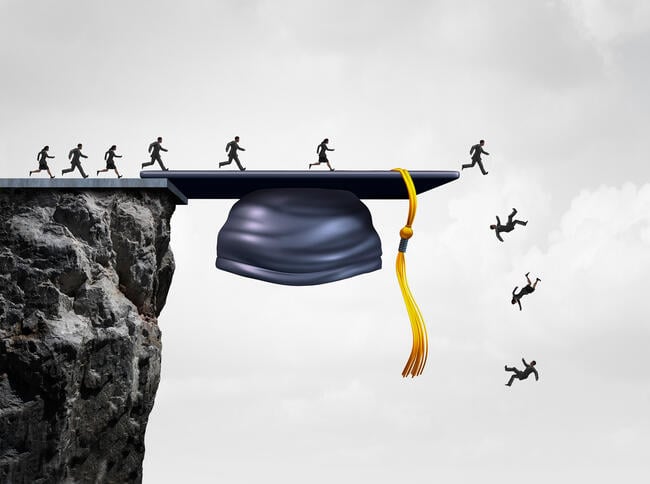You have /5 articles left.
Sign up for a free account or log in.

wildpixel/iStock/Getty Images Plus
The failure of Congress to reform the Higher Education Act since its last reauthorization in 2008 has had devastating consequences for America’s students and taxpayers. For too long, the federal response to rising costs and dismal completion rates has been to throw more money at the problem. The decision to raise the borrowing rate for undergraduates starting in 2007–08 for the first time in more than 10 years allowed students to take on an unprecedented amount of debt to finance their education, while the accountability measures demanded of colleges and accreditors did little to stem the tide of profligate spending, which had few, if any, benefits for students. Save for a few valiant attempts by former U.S. senator Lamar Alexander, Congress has been unable to find a broad enough bipartisan consensus in the 17 years since to undertake any meaningful structural reforms.
Left to its own devices, the higher education industry sleepwalked through the Great Recession and the COVID-19 pandemic, learning little and frittering away the public’s trust. High debt loads combined with educational priorities horribly misaligned with the needs of the country’s workforce have led to a 52 percent underemployment rate among recent graduates as well as a shrinking return on investment for many graduates—particularly those seeking advanced degrees. It is worth highlighting that this trend is not isolated to shady for-profit diploma mills; many elite, selective, private colleges and universities currently operate programs that leave graduates more than $100,000 in debt while struggling to earn a wage above the poverty line.
This is disgraceful. It should be a national scandal that taxpayers send $20 billion a year to institutions that graduate fewer than half of their students in six years, as a recent Third Way analysis found. There should be protests over the statistic that more than one-third of students leave college with minimal cognitive gains. The boards of private “nonprofit” colleges should be called to account for how they can justify holding endowments valued at more than $580 billion and paying their executives an average of nearly $850,000, while their average student graduates with nearly $34,000 of debt. How can this industry continue to expect deference from politicians and the public in the face of such obvious, systemic abuses?
Leadership, accountability and, most of all, structural reform are desperately needed. The previous administration’s approach continued a decade-long trend of policymaking by executive fiat that wasted millions of dollars and thousands of hours of labor as colleges and universities were forced constantly to retrain their staff and shift their policies to comply with the latest executive order or departmental guidelines. Furthermore, its signature policy of student loan forgiveness was akin to bailing out a sinking ship without even trying to patch its holes. While it may have served to ease the burdens faced by some borrowers, it completely failed to address the reason for their distress. It was profoundly frustrating to see the Biden administration recognize that there was a student loan crisis yet decline to hold those who caused it accountable. These trends cannot continue. Real reform will require congressional action, and thus, a bipartisan coalition with the goal of common-sense reform.
Accreditation is perhaps foremost among higher education’s institutions that require attention. As the guarantors of academic quality, the accreditors’ proper role is to evaluate colleges and universities to ensure that institutions receiving federal funding are providing an education that delivers real, tangible value. The HEA notably does not define what student success looks like and, in fact, limits the ability of the Department of Education to require that accreditors consider specific variables or set performance floors for institutions. Accreditors thus have both a broad latitude to set the standards they use to evaluate colleges and, as the gatekeepers for access to federally backed student loan funding, a powerful cudgel to compel institutions to adhere to these standards.
With the power to hold colleges and universities accountable in the hands of higher education experts, how is it that student outcomes have floundered? Simply put: The accreditors are not effective at curbing the worst excesses of these institutions. For example, the University of North Carolina at Chapel Hill spent 18 years funneling more than 3,100 student athletes into no-show “paper classes” designed to inflate their GPAs. The university’s punishment for facilitating thousands of instances of academic fraud? It was put on probation for one year by its accreditor, the Southern Association of Colleges and Schools, a decision that did little materially to impact the institution beyond serving as a “tremendous embarrassment.”
Another example of accreditor inaction can be found in the wake of the Jerry Sandusky child sexual abuse scandal at Pennsylvania State University. An independent report castigated the institution for propagating a culture of silence where “in order to avoid the consequences of bad publicity, the most powerful leaders at the university … repeatedly concealed critical facts relating to Sandusky’s child abuse.” The National Collegiate Athletic Association acted quickly, fining Penn State $60 million. In contrast, its accreditor, the Middle States Commission on Higher Education, put the institution on warning for three months.
Baker College was fined $2.5 million by the Department of Education in January after it determined the private nonprofit Michigan institution had misrepresented the job placement rates and salaries of its graduates on its website. A 2022 investigation by ProPublica and The Detroit Free Press found that the college had boasted nearly 100 percent employment rates for graduates “for decades,” while neglecting to mention that “that less than one-quarter of its students graduate”—or “that 70 percent of Baker students who took out federal student loans have problems making payments two years after leaving college.” Baker’s accreditor, the Higher Learning Commission, reaffirmed the college’s accreditation in 2020.
These are just a few of the most visible scandals where accreditors failed in their roles. For every headline-grabbing abuse, leaders at colleges and universities make a thousand mundane decisions—from pricing lower-income students out of an education to grade inflation, from the hollowing out of core curricula to prioritizing administrative over instructional spending—that ultimately betray their educational missions. In an ideal world, accreditors serve as a check against these abuses. Instead, their stubborn focus on evaluating performance based on inputs rather than outputs (such as student outcomes) has led them to be resistant if not overtly hostile to much-needed innovations and alternative educational pathways like microcredentials, competency-based education, apprenticeships and the 90-credit-hour degree.
The new administration seems determined to double down on executive orders as the primary driver for policy change. President Trump recently signed an order directing the closure of the Department of Education “to the maximum extent appropriate and permitted by law.” In the meantime, deep staffing reductions at the department seem likely to weaken its few, meager enforcement and accountability measures. Of particular concern are cuts to the data systems that serve as the cornerstone for countless independent projects that provide sorely needed public transparency to a normally inscrutable field. This approach renders doubtful the possibility that lasting reform will come from the executive branch or its agencies. With the toothlessness of the accreditors unlikely to change without external intervention, and the states seemingly content to focus on regulating public institutions while largely rubber-stamping the actions taken by private colleges, there is only one body that can offer meaningful reform for the entire industry: Congress.
Since the 2008 reauthorization, Congress has yielded its policymaking authority to secondary actors. Presidents, bureaucrats and colleges have taken advantage of this passivity to further their own goals, directly leading to our current morass. Rather than seeking to whitewash the failures of our existing system of quality assurance, Congress needs to reimagine it. There have been a number of positive proposals—including the risk-sharing provisions of the College Cost Reduction Act as well as the financial value and transparency measures first introduced during the Biden administration—that have failed to advance due to partisan squabbling or resistance from the colleges themselves. Holding colleges accountable for poor student outcomes ought not be a partisan issue, nor should improving access for the most financially disadvantaged Americans. For nearly two decades, countless common-sense, transparency-based solutions to these issues have been neglected by lawmakers, including a proposal made by two former members of the National Advisory Committee on Institutional Quality and Integrity.
By utterly refusing to work with partners from across the political aisle, legislators are cowing to the whims of ideological actors seeking to engage in bad-faith critiques of the industry to gain an edge in the culture war. America’s students and taxpayers deserve real leadership from their elected representatives. Though industry insiders have been declaring various crises in higher education for decades, it truly does feel as though we are at an inflection point. The consequences for ignoring this clear need for significant structural reform will be another generation of lost learning, crippling debt and declining faith in a system that was once the envy of the world.








